The origins of today’s vast intelligence apparatus can be traced in part to the forgotten efforts of librarians and archivists to gather information during World War II
-
July/August 2020
Volume65Issue4
An unlikely band of American librarians and archivists mobilized during World War II in a forgotten war effort centered on books and documents. Helped by an odd assortment of scholars, spies, and soldiers, the information hunters gathered enemy publications in the spy-ridden cities of Stockholm and Lisbon, searched for records in liberated Paris and the rubble of Berlin, seized Nazi works from bookstores and schools, and unearthed millions of books hidden in German caves and mineshafts.
Improvising library techniques in wartime conditions, they contributed to Allied intelligence, safeguarded endangered collections, and restituted looted books — and built up the international holdings of leading American libraries for the postwar period. These men — and a few women — came together in a series of enormous collecting missions that originated in the unique conditions of World War II.
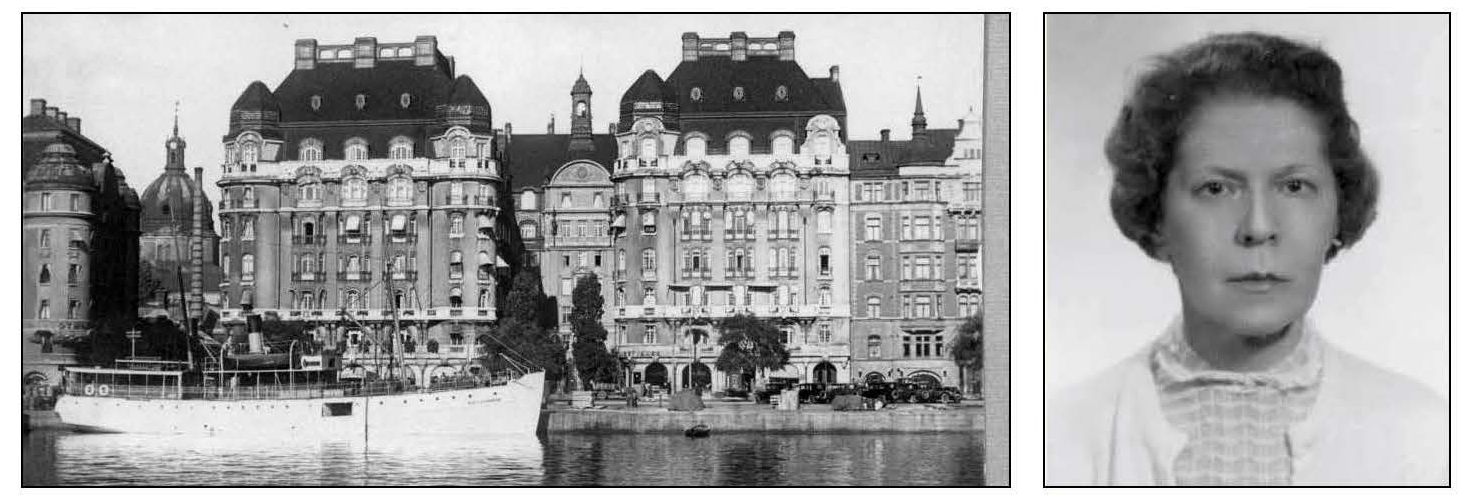
The information hunters offer a contrast to the Monuments Men, the well-known army unit of curators and museum specialists who saved endangered art and culture in wartime. More than in any previous American war, World War II required the mobilization of knowledge to fight the enemy, and books and documents drew the attention of many different decision-makers and personnel, civilian and military. Foreign publications were seen as a potent source of intelligence; only over time did questions of preserving libraries, restituting looted collections, and building American libraries emerge.
At the outset of the war, no one could have foreseen the large-scale government-led operations to acquire, exploit, rescue, and restitute books. It turned out that the expertise of librarians and scholars aligned closely with American military and political objectives. Although they were on the margins of battlefields, the experiences of these information hunters shed new light on the war and its impact on American life.
On the eve of World War II, the American government had only limited capacity for foreign intelligence gathering. The FBI compiled dossiers on domestic threats and intercepted mail, American embassies reported on foreign developments, and the armed services began to strengthen military intelligence. But the U.S. was far behind Great Britain and Germany. As the international crisis mounted, President Franklin Roosevelt came to believe the government needed a robust intelligence capability.
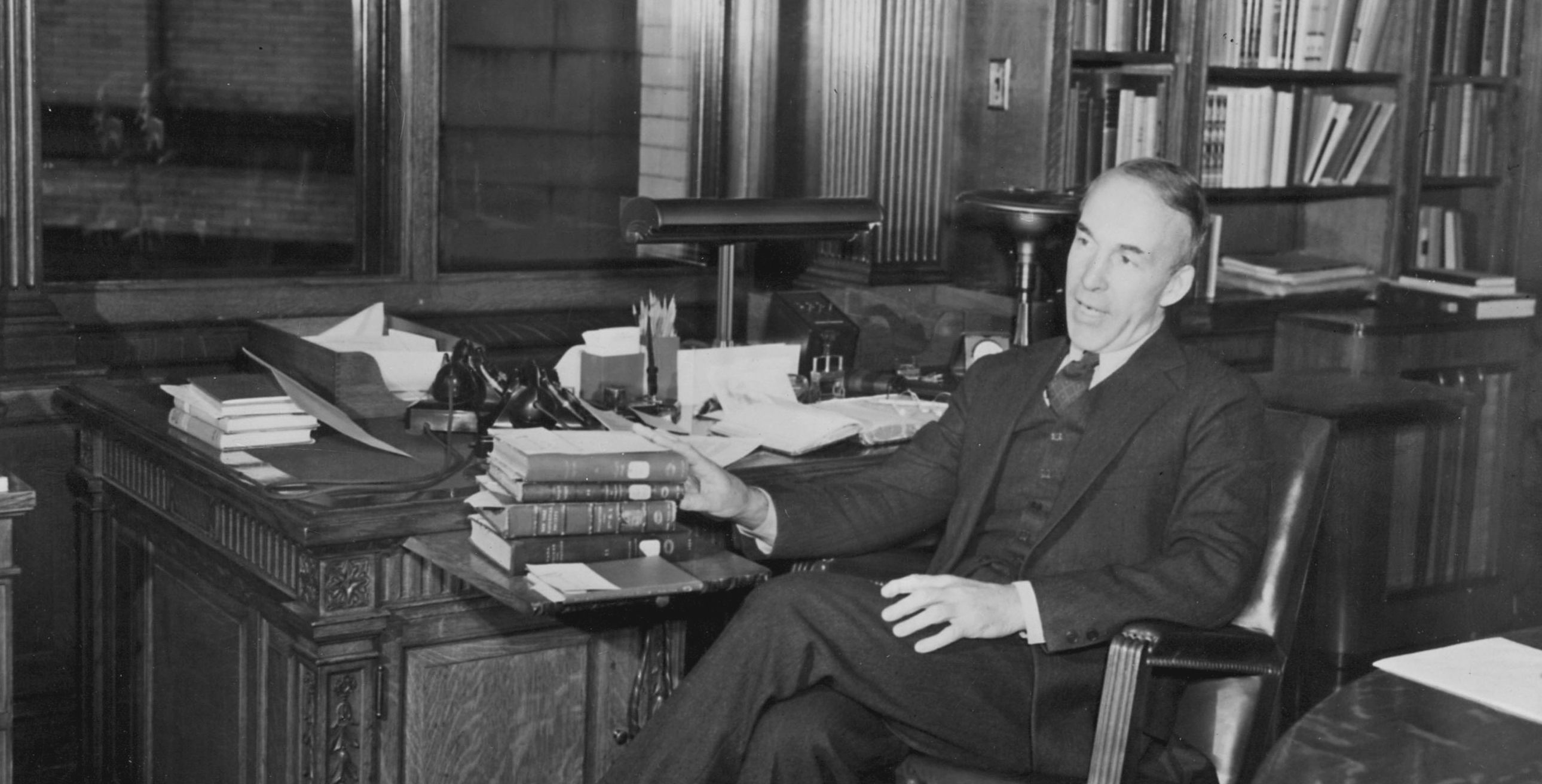
In July 1941 Roosevelt directed William “Wild Bill” Donovan, a decorated WWI veteran, lawyer, and politico, to build a civilian intelligence agency, which became known as the Office of Strategic Services or OSS. Initially the agency was called the Coordinator of Information, a significant name, for it was this new attention to information that led to the wartime collecting missions. It focused on the prosaic task of gathering and analyzing non-secret publications and documents.
Donovan enlisted the aid of Archibald MacLeish, the famed poet, playwright, and the Librarian of Congress. Under MacLeish, the Library of Congress had become the site of a new cultural-governmental alliance. An ardent interventionist, MacLeish urgently raised the stakes for librarians, calling on them to be not only custodians of culture but defenders of freedom.
Strangely enough, the origins of America’s vast intelligence apparatus might be traced to the meetings of these two men in the summer of 1941. Although Donovan would embrace espionage and secret operations, he initially turned to publicly available information to understand the enemy. MacLeish encouraged analyzing such sources using the methods and tools of scholarship, and he committed the Library to assist this effort. Foreign newspapers, scientific periodicals, industrial directories, and similar publications were in great demand. With the international book trade shut down by war, other means of acquisition had to be found. Not long after the attack on Pearl Harbor, Roosevelt created an agency for this purpose called the Interdepartmental Committee for the Acquisition of Foreign Publications (IDC).
The IDC got off to a slow start, failing to acquire a single item in its first four months. Finally in April 1942, it began to send librarians and scholars abroad to collect and microfilm these materials. Initially the committee thought it could get by with a couple of agents, but the program expanded quickly, with personnel placed in London, Stockholm, Lisbon, Istanbul, Cairo, New Delhi, and Chongqing.
Heading the Stockholm operation was Adele Kibre, the only woman to serve as an agent in the field. She grew up in Hollywood, in a family connected to the film industry, but she had a scholarly bent and went to the University of Chicago to earn a PhD in medieval linguistics. Like many women of her era, she was denied an academic career. Instead, she carried on her own research while employed by senior faculty to go abroad and copy rare books and manuscripts. At the Vatican Library in 1934, she observed other scholars “rapidly filming their research materials with miniature cameras,” and she trained herself to do the same.
Adele was in Germany when war broke out, experienced an air raid drill in the Prussian State Library in Munich, left Paris just before the German invasion, made her way to Lisbon, and landed in the United States in March 1941. Soon she returned to Europe, this time to head the Anglo-American Microfilm Unit in Stockholm, reproducing enemy publications for U.S. and British intelligence. She developed channels to acquire works through local booksellers, sympathetic academics, librarians, and government agencies. She also had contacts with the Danish resistance and the clandestine press, and worked with the British to smuggle technical manuals from Germany into Sweden. She was the most effective agent in the OSS acquisitions program, producing over 3,000 reels of microfilm and supplying many books to London and Washington.
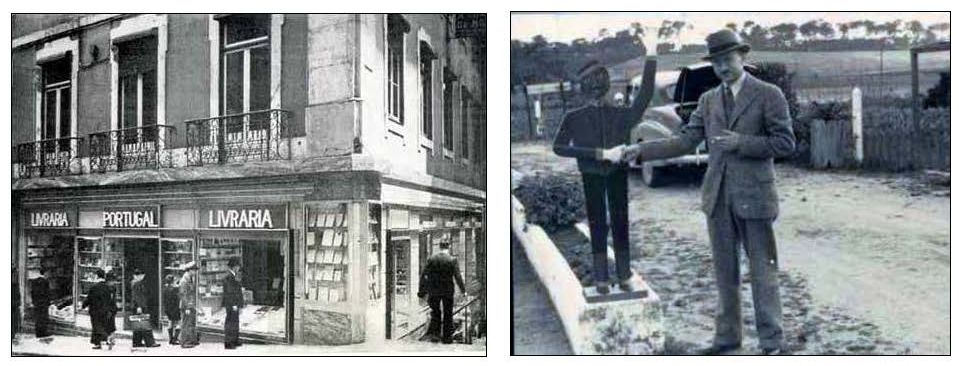
The other large European operation was in neutral Lisbon, where, despite the dictatorship of Antonio Salazar, book dealers and newsstands did a brisk business in German and other European publications. Lisbon was a magnet for intelligence agents from all the warring countries. These included several American librarians: microfilm expert Ralph Carruthers and librarian Reuben Peiss for the OSS, and Manuel Sanchez, sent by the Library of Congress. Sanchez arrived first, and, after shaking off Portuguese undercover agents tailing him, started to purchase works on the open market and gain access to secret materials.
A dashing and popular figure who called his employer “Elsie” (for LC), Sanchez portrayed himself as a character in a spy novel. His closest contacts were the Andrade brothers, Portuguese bookstore owners and Allied sympathizers, who went with him to Franco’s Spain; there they approached German-owned bookshops, where it would have been too dangerous for Americans to collect on their own.
The OSS men, Carruthers and Peiss, competed with Sanchez for acquisitions. They made the rounds of bookstores, took buying trips into the hinterland, and cultivated sympathetic locals to loan secret items or serve as ‘fronts’ for subscriptions. Initially the IDC was able to ship 165 pounds a month on the Pan Am Clipper, a negligible amount. The Lisbon agents microfilmed most of the material they acquired in order to reduce the bulk of the publications. Their camera equipment, housed in an out-of-the-way room in the American legation, was often going day and night.
The result was a massive and nearly overwhelming quantity of microfilmed materials. By the end of 1942, the first year of operations, 1.2 million pages had been duplicated and distributed to US government agencies, and the numbers continued to grow. It is difficult to gauge the actual intelligence value of these acquisitions. Despite the Committee’s claims, their operational importance seems limited when compared to such information sources as signals intelligence. Nevertheless, newspapers and technical works directly from Axis and occupied countries could be mined for useful data, for example, indications of enemy troop strength, new weaponry, industrial production, even enemy battle deaths.
Many wartime officials perceived open sources to be highly important and invested considerable energy analyzing them. To make them useful, new techniques of information management were employed to transform books and serials into the genre of intelligence — extracting useful material, indexing it, providing abstracts, and doing full text translations in forty-two language. Information — disaggregated content — not the publications themselves, was the intelligence product. In a time before computers were available to aid in this work, the OSS hired a small army of indexers and translators, most of them women and émigrés.
The OSS mission to collect enemy publications in neutral cities became less important after D-Day. At that point, the information hunters became integrated into military operations. They were assigned to document gathering teams known as T-Forces, which followed behind the Allied armies as they advanced, scouring ‘targets’ for operational or strategic information. Wearing military uniforms and operating under army command, they served as specialists able to assess and select archival records and publications, often on the fly.
Although an unlikely role for bibliophiles and scholars, some of them took to this work with gusto. Private Max Loeb — a German-born journalist, émigré, and New York bookseller before his war service — had the idea of interrogating German prisoners-of-war in Great Britain who had worked in libraries and the book trade. Aiming to discover the whereabouts of important collections, he turned up much information of value to military intelligence.
Another agent, Ross Lee Finney, was an avant-garde composer and music professor at Smith College who volunteered to do OSS acquisition work. He arrived after the liberation of Paris, going from target to target identified on a long list. As he wrote his wife, “my work involved slightly different methods of acquiring foreign publication than I or anyone in Northampton [Massachusetts] would use.” He learned how to interrogate informants and follow suspicious people — “I find I’m pretty good at sniffing down an alley and tracing things,” he said — and he found massive quantities of printed materials to confiscate. On Thanksgiving Day, 1944, he made his “biggest discovery,” a huge cache of patent abstracts.
T-Forces looked especially for material with immediate value for military operations, research related to weaponry, aeronautics, and other war-related fields, and records that would be useful in the prosecution of war crimes. But there was also a degree of mission creep, and in the final stages of the war, they seized a wide variety of works that might later be exploited. Max Loeb found “so many tempting targets” that “even after a good and successful day” — when he had seized 1,000 books and runs of twelve periodicals — he felt “uneasy, because there is still so much undone.”
Ordered to respect the integrity of academic and public libraries, they considered collections in the service of Nazi ideology — such as the Institute for Race Science, housed in a university library — to be “fair game.” They took endangered books as well: As one officer in Cologne explained, “we have felt no qualms about going into rubble which used to be [bookstores] and removing any items of value.” T-Forces considered the early phase of occupation, when civil affairs officers had not arrived, the “period of the snatch,” when “the lid is literally off and almost anything goes.” But it was another story when military government was in place, as one officer in Bonn found: going into a bookstore, he felt too uncomfortable “just seizing the stuff and stalking off,” so he paid cash for the lot.

As the investigators dug more deeply, they found vast quantities of books and other publications stashed in surprising places. In the wake of bombing raids, German authorities had relocated state archives, library collections, and looted books to outlying areas.
Americans discovered a salt mine at Ransbach where gold, artworks, and the costumes of the Berlin State Opera had been stored — along with part of the Prussian State Library. Piled up in tunnels were two million volumes, historical records, maps, films, and a rare geographic library, but no card catalogue.
Tragically, a fire had burned for several months in the mine, likely set by refugees trying to keep warm, and, as an investigator reported, the books were “in the process of gradual destruction from fumes, smoke, and dampness.” This was only one of twenty-five places where the library had been deposited. By July, 1945, the Monuments Men had identified over “800 mines, castles, country houses, churches, hospitals and other public buildings which contain works of art, archives, and libraries,” and the number continued to grow.
This wartime history laid the groundwork for the treatment of books during the period of Allied occupation. Mass collecting missions might simply have ceased or narrowed in scope when the war in Europe ended in May 1945. Yet the opposite occurred. The needs and interests of the American library world, civilian government, and the military occupation converged, leading to the expansion of librarians’ involvement abroad.
The war experience and Allied victory spurred research libraries to assume a more prominent global role, which required deeper and more extensive international holdings. During the war, leaders of the Library of Congress, New York Public Library, and top university libraries had committed themselves to a vision of American dominance and adopted a cooperative program, known as the Farmington Plan, to achieve that vision.
Archibald MacLeish wanted to “have somewhere in the country every book in the world,” and his successor, Luther Evans, argued that such holdings were a matter of national security. At the same time, American libraries competed fiercely with each other — this was not the genteel world one assumes when thinking about libraries — and now that the war was over, they schemed to get back into Europe. The military increasingly grew concerned about librarians running around former battlefields and devastated cities, scooping up books.
In the summer of 1945, the Library of Congress proposed a mission to acquire books for all American research libraries. It was initially conceived as a book purchasing operation, to fill wartime gaps by buying three copies of all publications issued in Germany and occupied countries since 1939, when the international book trade had been suspended. It was also instructed to recover $250,000 worth of books bought by American libraries before the war and held in safekeeping near Leipzig, in the Soviet Zone of Occupation. The War and State Departments agreed to the proposal, drawing upon the expertise and model of the OSS program for the acquisition of foreign publications. Reuben Peiss was transferred from the OSS to lead the Library of Congress Mission in the early fall of 1945, and a group of librarians from the U.S. joined him in January 1946.
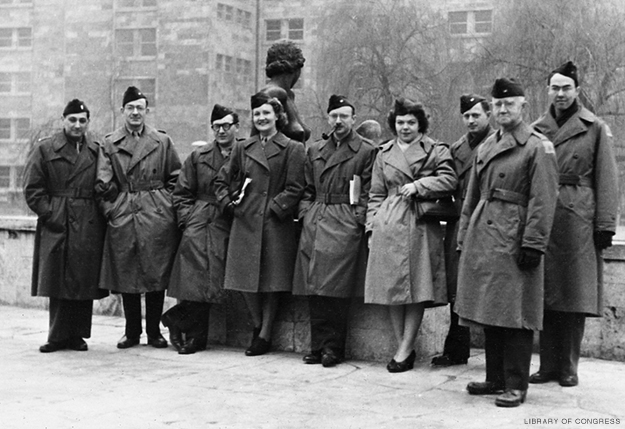
What was initially a narrowly defined mission evolved into a mass-scale program of acquisition. The Library of Congress representatives operated under the authority of OMGUS, the U.S. occupation government in Germany, which authorized them to go into research institutes and libraries where they examined and confiscated materials. They screened and evaluated the vast quantities of publications that had already been seized by T-Forces and intelligence units; those not needed by the military were shipped to the U.S., for the Library of Congress and research libraries. They also seized documents and ephemera, such as the famed Rehse Collection of posters, pamphlets, and other materials documenting the Nazi era.
A crucial dimension of Allied occupation policy — the denazification of Germany — involved the information hunters. Books with Nazi or militaristic content were confiscated, German bookstores and libraries shuttered, and objectionable works put under lock and key. This turned out to be a vast undertaking, including everything from academic treatises to school textbooks and popular fiction. Over time, the Allies adopted a strict policy, known as Order No. 4, to seize and destroy all literature and material of a Nazi nature, including works that promoted fascism, militarism, nationalism, antisemitism, racism, and civil disorder.
When word of the directive hit the press in the United States, Americans were outraged. During the war, government posters had condemned Nazi book burnings, with such slogans as “books cannot be destroyed by fire.” Order No. 4 seemed to betray the very ideal of freedom for which Americans had fought the war. To counter this negative publicity, the Library of Congress Mission preserved copies of each objectionable work for future research and as a record of Nazism, with the rest sent to paper mills for pulping to produce essential paper stock. In this way, ironically, librarians became part of the machinery of destruction. The execution of the policy was uneven, and the number of Nazi and militaristic books destroyed is unknown. However, about two million volumes made their way to American university libraries — a windfall of publications.
Among the wartime missions involving books, the most significant was the restitution of books looted from Jewish individuals and institutions. The looting teams of Nazi ideologist Alfred Rosenberg had seized countless volumes to create an Institute for Research into the Jewish Question, even as the regime killed millions of Jews in the Holocaust. In April 1945, American troops discovered about two million looted works in the small village of Hungen. Two months later, a Jewish-American officer found the bombed remains of Rosenberg’s Institute in Frankfurt; seeing scraps of paper in Hebrew on the ground led him to a cellar filled with Torah scrolls and Jewish books.
The Monuments Men addressed the unanticipated problem of gathering, preserving, and restituting these displaced books. Some of the collections had obvious identifying marks and could be rapidly restituted to the country of origin, as stipulated by Allied policy. However, many were not immediately identifiable, their owners dead, or their whereabouts unknown. Initially the books were housed in the Rothschild Library in Frankfurt, where efforts to gather, identify, and organize these works for restitution were slowed by limited personnel and difficult working conditions.
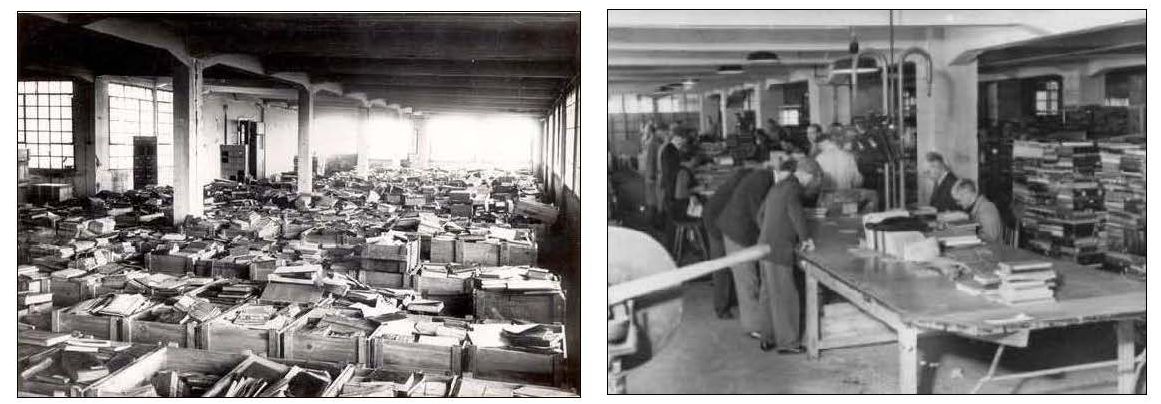
Finally, the books were relocated to a large warehouse, called the Offenbach Archival Depot. A Jewish-American military officer and professional archivist, Seymour Pomrenze, was put in charge, followed by Isaac Bencowitz, a chemist and veteran of the two World Wars. These gifted administrators developed a large-scale book processing plant and designed work flows to handle numerous books in many language, often in poor physical condition or defaced.
To identify them rapidly, Bencowitz had the idea of photographing bookplates and book stamps; the German workers memorized a small number of them and sorted the books into boxes accordingly. In two years, the Depot restituted or returned 3.2 million items, but even so, there were over 360,000 unidentified and orphaned works remaining. These posed a thorny political question, with many different agencies, including Jewish ones, claiming the right to decide their fate. Ultimately a U.S.-based international organization, Jewish Cultural Reconstruction, Inc., was given the authority to do so. The group consisted of many Jewish scholars, lawyers, and religious leaders, and its executive secretary was Hannah Arendt. It sent 43% of the books to Israel and 38% to the United States (about 160,000), with the rest to Jewish institutions in South America, Africa, and a small number to western Europe.
What was the impact of the information hunters? As gatherers of open-source intelligence, they contributed less to immediate combat needs and more to the military’s general ability to understand the enemy and plan for the Allied occupation. The publications they acquired revealed German discoveries and technical innovations that gave American science and industry a leg up after the war.
The information hunters also played an important role in the process of denazification. Not only did they uncover records and films that became part of the documentary evidence of war crimes at the Nuremberg Trials, they worked to eliminate Nazi and militaristic works from German culture, as a step toward the creation of a democratic Germany. And in the long run, the wartime efforts of librarians, collectors, and information specialists set the stage for the postwar expansion of American research libraries, led to the emergence of modern information science, and offered a touchstone for later efforts to safeguard cultural heritage.

